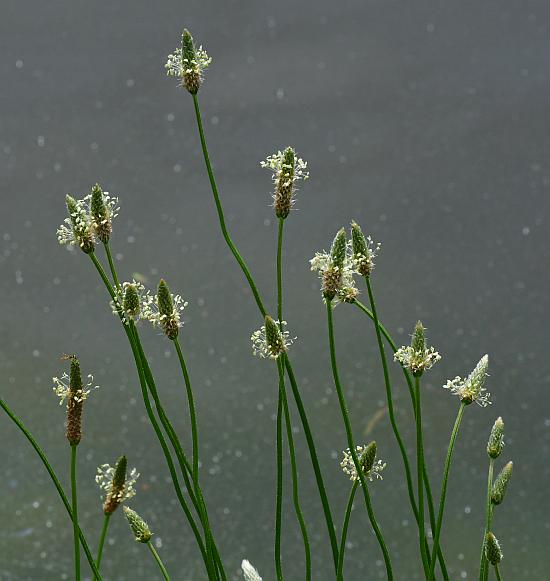Plantago lanceolata L.
English Plantain

Introduced
CC = *
CW = 3
MOC = 80
© SRTurner
Plantago lanceolata L.English Plantain | |
 |
Introduced CC = * CW = 3 MOC = 80 |
© SRTurner |
|
Family - Plantaginaceae Habit - Perennial forb with numerous, slender, fibrous roots and sometimes also a taproot, the rootstock occasionally branched at the tip (this often appearing woolly with tan hairs). Stems - Aerial stems absent or very short. Leaves - Basal in a dense rosette, sessile or with obscure, broadly winged petioles, usually wine-colored to purplish-tinged at the base, loosely ascending to arched or spreading. Leaf blades 10-40 cm long, 7-35 mm wide, narrowly elliptic to narrowly lanceolate or elliptic-lanceolate, angled to a usually sharply pointed tip, tapered at the base, the margins entire or with a few widely spaced teeth, the surfaces glabrous or sparsely to moderately pubescent with curved to spreading hairs (sometimes more densely so on the undersurface), appearing green to dark green, with 3 to several main veins, these all arising from the blade base and appearing more or less parallel.
Inflorescences - One to more commonly several per plant, terminal, elongate spikes, 1.5-8.0 cm long, 6-10 mm in diameter, densely flowered for the entire length (the axis not visible between the flowers) or the lowermost flowers sometimes more widely spaced, the stalk 12-55 cm long, ascending to erect, hairy, the axis solid, somewhat 5-angled in cross-section. Bracts with the body 1.5-3.0 mm long, shorter or longer than the flowers (the body slightly shorter than the calyces), ovate, with broad, translucent margins and a slender, not or only slightly keeled, green midnerve, often tapered into a slender awnlike or hairlike tip up to as long as the body, glabrous. Cleistogamous flowers absent.
Flowers - Calyces appearing 3-lobed (derived from 4 lobes but with the 2 lobes adjacent to the bract fused into a usually apically notched structure with 2 midnerves), 1.8-3.0 mm long, zygomorphic, ovate (the fused pair broadly oblong-ovate), sharply pointed at the tip, the slender midnerve glabrous or more commonly hairy toward the tip, the broad, translucent margins thin and papery. Corollas not noticeably zygomorphic, the lobes 2.0-2.5 mm long, narrowly ovate with a shallowly cordate base, sharply pointed at the tip, the margins entire, translucent white to tan, all of the lobes spreading to reflexed at flowering, reflexed at fruiting. Stamens 4.
Fruits - Capsules 3-4 mm long, ovoid to obovoid, circumscissile near the base. Seeds mostly 2 per fruit, 1.7-2.2 mm long, oblong-elliptic to ovate, the surface with a flattened or slightly concave area on 1 side, otherwise finely pitted, yellowish brown to brown, shiny. Flowering - April - October. Habitat - Streambanks, pond margins, marshes, forest openings, fields, pastures, lawns, gardens, fencerows, railroads, roadsides, open disturbed areas. Origin - Native to Europe. Lookalikes - None. Other info. - This species can be found throughout Missouri and most of the continental U.S. It is introduced nearly worldwide. It is very common in lawns and other disturbed habitats and is probably one of the most familiar weeds in the state. It is a familiar sight to nearly everyone, but many people don't know what it is. Other common names include "ribwort plantain," "lamb's tongue," and "bulletweed." It is easily recognized by its distinctive inflorescences on long stalks arising from leafy rosettes. The inflorescences are initially bullet-shaped but can grow very long under favorable conditions. Though an introduced weed, the plant can still be rather attractive when flowering, with the ring of extended stamens lending a tutu-like appearance to the heads. Photographs taken in Kansas City, KS., 6-10-00, in Vale, NC., 3-15-03, and in Eminence, MO., 6-15-03 (DETenaglia); also in Washington, Franklin County, MO, 6-4-2020, and near Labadie, Franklin County, MO, 6-5-2020 (SRTurner). |